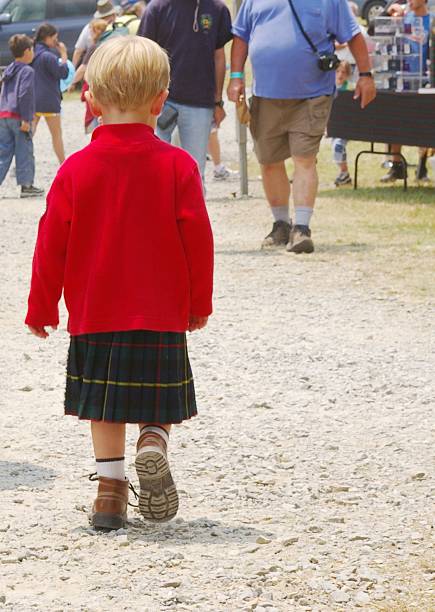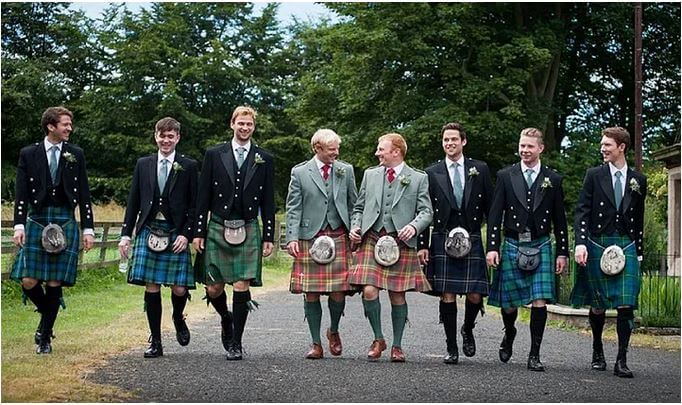Welcome to the world of kilts, where tradition meets style and heritage intertwines with fashion! Kilts have been a symbol of cultural identity for centuries, representing various countries’ rich history and customs. From swirling tartans to bold patterns, these traditional garments exude elegance and masculinity. But which countries proudly don this iconic attire?
Join us as we unravel the global tapestry of kilt-wearing nations. Whether you’re a history enthusiast or simply curious about fashion trends worldwide, this article will take you on an exciting journey through time and across continents. So grab your virtual passport, and let’s explore together: Which countries wear kilts?
Which Countries Wear Kilts?
Kilts, the traditional Scottish garment that exudes charm and elegance, is not only confined to Scotland. Several countries worldwide embrace this iconic attire as a symbol of their cultural heritage. Let’s journey across continents to explore some of these fascinating nations.
Scotland – The Birthplace of Kilts
Unsurprisingly, Scotland takes centre stage when it comes to kilts. Considered the birthplace of this distinctive garment, kilts hold deep historical and cultural significance in Scottish tradition. From tartan patterns representing different clans to accessories like sporran and sgian-dubh, wearing a kilt is an integral part of traditional Scottish dress for both men and women.
Ireland – The Celtic Connection to Kilts
Moving westward from Scotland, we arrive in Ireland – another country with solid Celtic roots where kilts have found their place. While not as prevalent as in Scotland, Irish kilts showcase unique regional variations influenced by Gaelic culture. These kilts often feature intricate designs and vibrant colors reflecting Irish heritage’s rich tapestry.
Other European Countries with Kilt Traditions
Beyond Scotland and Ireland, other European countries also proudly wear kilts as part of their cultural identity. For instance, in Wales – known for its distinct language and traditions – you can find people donning Welsh kilts during special events or festivals celebrating Welsh culture.
Similarly, in Brittany (France) and Galicia (Spain), regions with Celtic connections like Ireland and Scotland, a small but dedicated community proudly wears regional versions of the kilt on certain occasions.
Non-European Countries that Embrace the Kilt
Interestingly enough, you might be surprised to learn that even non-European countries have embraced the allure of wearing kilts. One notable example is Canada, where many citizens celebrate their Scottish heritage by participating in Highland games while dressed in full Highland regalia, including kilts.
In countries like the United States, Australia, and New Zealand have adopted the kilt as a symbol of pride and heritage.
Scotland – The Birthplace of Kilts
One country immediately comes to mind when you think of kilts – Scotland! This picturesque land is known for its breathtaking landscapes and castles and for being the birthplace of the kilt. The Scottish kilt is a symbol of national pride and tradition.
The origins of the kilt can be traced back centuries ago in the rugged Highlands of Scotland. Initially, it was like a giant fabric wrapped around the body and belted at the waist. Over time, this evolved into what we now recognize as the classic pleated tartan kilt.
Kilts were not just clothing; they were a way for clans to identify themselves and showcase their unique heritage. Each clan had its distinct tartan pattern, representing their lineage and history. Today, these patterns are still proudly worn by Scots worldwide.
In Scotland, you’ll find kilts donned on special occasions such as weddings, ceilidhs (traditional Scottish dances), and Highland games. These events allow Scots to celebrate their cultural roots while showcasing their dapper style in kilts adorned with sporran pouches and sgian-dubh knives.
Scottish men aren’t alone in embracing this iconic garment; women have also found ways to incorporate kilts into their wardrobes. Tartan skirts are popular among ladies who want to express femininity and Scottish pride.
So next time you visit Scotland or attend a Scottish-themed event, watch for those striking kilts swaying in the wind! They’re not just garments; they represent centuries-old traditions woven into every thread.
Ireland – The Celtic Connection to Kilts
When it comes to kilts, Scotland often takes the spotlight. However, Ireland, too, has a deep connection to these iconic garments. Ireland has unique kilt traditions as a country with strong Celtic roots.
In ancient times, Irish warriors known as Fianna would wear a garment called the léine in battle. This was essentially an early version of the kilt, made from long strips of fabric and worn over leggings or trousers. The léine allowed for freedom of movement during combat while still providing protection.
Today, kilts are commonly seen at Irish weddings and other formal occasions. They are typically made from tartan patterns that reflect specific family clans or regions within Ireland. These kilts are often paired with traditional accessories such as sporran pouches and brooches.
While kilts may not be as prevalent in everyday Irish attire as in Scotland, they still hold significance in Irish culture. They serve as a reminder of Ireland’s rich history and Celtic heritage.
So, next time you’re attending an Irish wedding or exploring the stunning landscapes of this beautiful country, keep an eye out for those stylish kilts that pay tribute to Ireland’s Celtic connection!
Other European Countries with Kilt Traditions
While Scotland may be the birthplace of kilts, it’s not the only country in Europe that embraces this traditional garment. There are a few other countries where you can spot people proudly sporting kilts.
One such country is Norway. The Norwegians have their version of the kilt known as “bad”. This traditional folk costume includes a knee-length skirt for both men and women. It is often worn during special occasions or festivals to showcase national pride and heritage.
In Germany, particularly in Bavaria, you might come across men wearing what is known as lederhosen. Although not precisely a kilt, these leather shorts bear some resemblance to Scotland’s iconic garment. Lederhosen is commonly worn during Oktoberfest celebrations and other cultural events.
Moving further east, we find ourselves in Poland. Here, an ancient tradition called “góral” involves wearing colourful woollen skirts called “stroje ludowe”. While primarily worn by women, men don these skirts as part of their regional attire.
The Basque Country, situated between Spain and France, also has its take on kilts. The Basque people wear a unique type of pleated skirt called “txapela”, which forms an integral part of their traditional dress.
These examples demonstrate how different European countries have incorporated variations of kilts into their cultures over time. It shows that while initially associated with Scotland, kilts have transcended borders and become symbols of European cultural identity.
Non-European Countries that Embrace the Kilt
The kilt, a symbol of Scottish heritage and pride, has captivated European countries and found its way into cultures beyond Europe. Let’s explore some non-European countries that have embraced this unique garment.
One such country is Canada, which has solid ties to Scottish culture due to the many Scottish immigrants who settled there. Many Canadians proudly wear kilts during Highland games and other cultural festivities.
Moving across the Atlantic Ocean, we find ourselves in New Zealand. This Pacific island nation boasts a vibrant Scottish community that embraces kilts as part of its cultural identity. Whether for weddings or national festivals, you’ll see Kiwis donning tartan patterns with pride.
Heading further south, we reach Argentina. Yes, even in South America, kilts have made their mark! The Argentine capital of Buenos Aires hosts an annual Celtic festival called “Fiesta Celtica”, where locals showcase their love for all things Celtic – including kilts!
Next on our list is Japan. Surprised? Don’t be! Japanese enthusiasts have developed a fascination for Scottish culture and fashion trends. They often incorporate traditional tartans into modern streetwear outfits or use them as costumes during festivals like Halloween.
Last but certainly not least is Australia – another non-European country where kilt-wearing enthusiasts can be found! With a rich history of immigration from Scotland dating back centuries ago, Australians enjoy showcasing their connection to Scottish roots by wearing kilts at various gatherings and celebrations throughout the year.
From North America to Oceania and even South America and Asia – these non-European countries prove that the allure of the kilt knows no bounds. So next time you travel abroad or attend an international event, keep your eyes peeled for those proud individuals sporting this timeless garment from Scotland.
Modern Adaptations and Popularity of Kilts Worldwide
Kilts, once limited to their traditional roots in Scotland and Ireland, have now found their way into the fashion scenes of various countries worldwide. With their unique design and rich cultural significance, kilts have become a symbol of individuality and style for many people.
In recent years, there has been a surge in modern adaptations of kilts that cater to different tastes and preferences. Designers have experimented with diverse fabrics, patterns, and colors to create contemporary versions that appeal to a broader audience. From tartan prints in bold hues to sleek leather designs, these modern kilts offer individuals a chance to express themselves while embracing tradition.
The popularity of kilts has also spread beyond European borders. Countries like Canada, Australia, New Zealand, and the United States have seen an increasing number of kilt enthusiasts proudly wearing them during special events or as part of everyday attire. These nations embrace the kilt not only as a nod to their Celtic heritage but also as a symbol of multiculturalism and inclusivity.
Social media platforms like Instagram have played an instrumental role in promoting the global appeal of kilts. Influencers from around the globe share photos showcasing how they incorporate this versatile garment into their style. This exposure has further amplified interest in wearing kilts worldwide.
Moreover, celebrities from different industries have embraced kilts on red carpets or during performances, making them more mainstream than ever before. From musicians such as Lenny Kravitz rocking leather kilts on stage to actors like Samuel L. Jackson donning tartan variations at premieres – these influential figures help solidify kilts’ position within pop culture.
As we navigate through an increasingly interconnected world where cultural boundaries blur together seamlessly, it’s no surprise that traditional garments like the kilt find new homes far away from their origins. The adaptability and versatility offered by modern interpretations make it easier for people from all walks of life to incorporate kilts into their style.
Conclusion
Kilts have a rich history and cultural significance in various countries worldwide. While Scotland is undoubtedly the birthplace of kilts, other European nations such as Ireland also embrace this traditional attire with their unique twist. Additionally, non-European countries like Canada and New Zealand have adopted the kilt as a symbol of pride and heritage.
The popularity of kilts has transcended borders and cultures, with modern adaptations making them accessible to people from all walks of life. Whether worn for special occasions or incorporated into everyday fashion, the kilt captivates individuals who appreciate its timeless style.
So next time you attend a Highland gathering or admire someone sporting a kilt on the streets, remember that this iconic garment represents more than just fabric and pleats. It carries centuries of tradition, culture, and identity within its folds.
Whether you’re Scottish by blood or drawn to its allure, why not consider embracing your connection to kilts? After all, there are no limitations when celebrating heritage and expressing personal style through this remarkable piece of clothing!
So go ahead – join the ranks of kilt-wearers worldwide! Let your inner Highlander shine through as you proudly don this symbol of tradition wherever you may roam!








